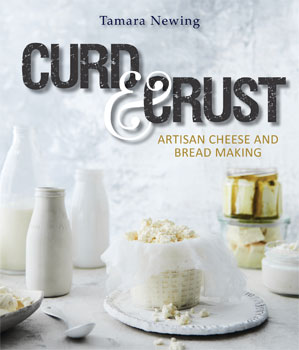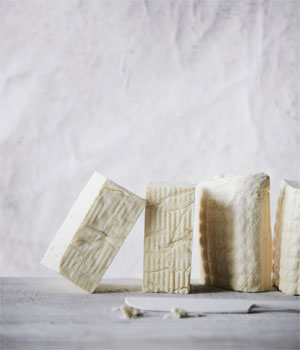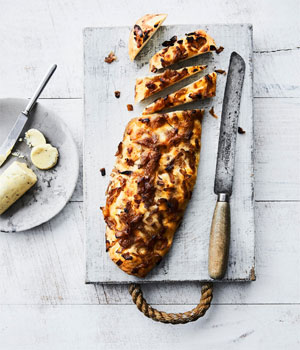Curd & Crust: Artisan Cheese and Bread Making

Curd & Crust: Artisan Cheese and Bread Making
Whether you're a cheese aficionado or novice cheese maker, Curd & Crust is a comprehensive introduction to cheese and bread making by chef and award-winning cheese maker, Tamara Newing.
It features the basics, advice, hints and tips to not only create your own cheese and bread but also recipes to incorporate them into delicious dishes.
In this cookbook, Tamara takes readers through various cheese styles made from different varieties of milk including cow, goat, buffalo, and sheep, as well as how to make the perfect bread and meal accompaniment.
Tamara Newing's first food love was bread-making and since 1989, she has taught thousands of her students how to make delicious bread as well as cakes, risotto and so much more, at her successful cooking school, Tamara's Kitchen.
During the 1990's, Tamara published six successful cookbooks, including her 'Risotto Round the World" and 'Bake Your Cake and Eat It Too". In addition her several reprints, she has also enjoyed weekly cooking segments on radio.
She now divides her time between her award winning artisan cheese making business 'BoatShed Cheese", teaching cheese making, and escorting cheese minded food lovers to France!
Curd & Crust: Artisan Cheese and Bread Making
New Holland Publishers Australia
Author: Tamara Newing
RRP: $35
 Haloumi
Haloumi
Makes: Approximately 1 kg (2 lb 4 oz)
Traditionally in the Mediterranean, haloumi was made from sheep's milk but in Australia it tends to be made from cow's milk which makes it a little more bland. I love to use a combination of sheep or buffalo milk and cow's milk (50% of each) but you can use all sheep's milk or all buffalo milk if you wish.
Ingredients
10 litres (10 quarts) sheep, buffalo or cow's milk or a blend
pinch of B Flora and/or MA4002
2 ml (0.006 fl oz) calcium chloride
2 ml (0.006 fl oz) vegetarian rennet
Method
Heat the milk to 33°C (91°F), add the cultures and stir well for 1 minute. Allow to rest for 30 minutes. Add the calcium chloride and stir well, then add the rennet and stir for a minimum of 1 minute and maximum of 2 minutes.
Allow to sit undisturbed for 1 hour until the curd has set and when tested with a knife, cuts cleanly without the curd slipping off the blade (see Basics – Techniques).
Cut the curd into 2 cm (¾ in) squares, stir briefly to ensure no large pieces remain. If you do see any large pieces of curd, quickly cut these to the approximate size of the rest of the curd. Allow the cut curds to rest for 10 minutes (this is called -healing'). Stir well for 2 minutes, then rest for a further 5 minutes.
Gently increase the heat of the curds and whey to 37°C (98°F) over the next 15–20 minutes, cutting the curds again until they are about half the size they were. Stir well intermittently so that the curds do not clump together. Allow to rest for 5 minutes so that the curds settle and the whey is covering the surface. The curds should have shrunk and now appear visible smaller.
Place a wire rack over your sink. Line a large, sanitised rectangular draining basket with a piece of sanitised cheesecloth then scoop curds out of the whey and into the draining basket until all curds have been removed from the whey. Fold the remaining cheesecloth neatly over the curd then place on the wire rack over the sink to drain.
Place a clean flat tray over the cheesecloth and add some items weighing at least 2 kg (4 lb 8 oz). Cans of food work well. After 1 hour, remove the tray, turn over the cheese still wrapped in its cheesecloth and return to the basket. Replace the tray and weights and leave for 1 hour. Remove tray and weights, turn cheese again and return to the basket without the tray and weights. Leave overnight.
The next day, cut the large piece of curd into pieces weighing about 250 g (9 oz) each then place in a saturated brine (see Basics – Technique) for 2–3 hours, depending on how salty you want it to be. Remove from the brine and allow the cheese to drain on a clean, sanitised rack overnight.
The next day, place the cheese on a tray and chill until dry, turning once. About 12 hours each side.
Store in an airtight container for up to 1 week, or vacuum seal and store in the fridge for up to 6 months.
 French Sourdough with Caramelized Onions
French Sourdough with Caramelized Onions
Makes 2 Loafs
The inspiration for this recipe comes from a similar bread bought in the food markets of St. Remy de Provence. It has a delicious, sweet-sour taste that marries beautifully with the sweetness of the caramelized onions. This is a fantastic choice when serving a Ploughman's Platter (a selection of cheese, cold cuts, relish and bread).
Ingredients
Starter
250 g (9 oz) plain yoghurt
150 g (5½ oz) wholemeal flour
3 tablespoons warm water
1 teaspoon sugar
Dough
3 tablespoons warm water
1 teaspoon sugar
300–450 g (10½–1 lb) wholemeal flour
1 tablespoon dried yeast
1½ teaspoons salt
1 teaspoon baking soda
4 large onions, sliced
50 g (1¾ oz) butter
Method
One day before:
In a large mixing bowl, combine 150 g (5½ oz) wholemeal flour, the starter, 1 teaspoon sugar and 3 tablespoons warm water. Mix well and set aside to ferment for 24 hours.
The next day:
Melt the butter in a large saucepan and add the sliced onions. Stir to coat with the butter and cook over medium heat until the onions are translucent. Cover the saucepan with a lid and continue to cook on a low heat for about 40 minutes, or until the onions are golden brown. Set aside to cool.
Mix the yeast, water and sugar together and allow to sit for 5 minutes. Mix this mixture into the prepared starter dough, with the salt and the caramelized onions. Slowly add more flour until the dough forms a shaggy mass. Tip the dough out onto a floured board or bench. Begin kneading the dough adding as much flour as necessary. When the dough is quite smooth and manageable, allow the dough to rise for 30 minutes.
Remove the dough from the bowl and divide in half. Shape each piece of dough into a flat oval loaf, about 1½ cm ( 5 ⁄ 8 in) thick, using your fingertips to add texture to the dough.
Drizzle the dough with some olive oil and allow to rest again for 30 minutes. Spray the dough with water and bake in a preheated oven at 200°C (400°F) for 25–30 minutes, or until crusty and golden. Note: Alternatively, if you prefer a more rustic version, reserve the onions until the bread is shaped then arrange over the top of the bread, covering the dough. Rise and bake as above
Curd & Crust: Artisan Cheese and Bread Making
New Holland Publishers Australia
Author: Tamara Newing
RRP: $35
MORE



